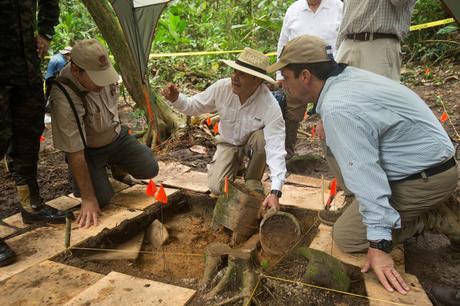 Last February a team of explorers and archaeologists traveled deep into the jungles of Honduras in search of a lost city. They had spotted what looked like the remains of ancient structures on satellite photos back in 2012, and after months of planning had finally set off to find what could be an important archaeological site. They spent days in the dense rainforest, facing numerous challenges that include picking up a nasty local parasite that left their health in jeopardy. But at long last they found the site they were looking for, and their hard work seemed justified.
Last February a team of explorers and archaeologists traveled deep into the jungles of Honduras in search of a lost city. They had spotted what looked like the remains of ancient structures on satellite photos back in 2012, and after months of planning had finally set off to find what could be an important archaeological site. They spent days in the dense rainforest, facing numerous challenges that include picking up a nasty local parasite that left their health in jeopardy. But at long last they found the site they were looking for, and their hard work seemed justified.But exhausted, low on supplies, and in failing health, they were forced to retreat. The plan was to return with more supplies and better equipment to begin excavation of the site. They team of researchers kept the location of the ruins hidden, and the Honduran government dispatched a military detail to guard it day and night to ensure that it remained undisturbed until a proper archaeological dig could begin.
Last week the team of explorers who discovered the hidden city returned at long last, and the excavation is now underway. According to National Geographic, Honduran President Juan Orlando Hernández was on hand this past Tuesday to remove the first stone sculpture from its ancient resting place, even as other archaeologists uncovered other artifacts all around him.
According to Nat Geo, the ancient relic that Hernández uncovered is an impressive piece. It is described as a jar that has been carved out of basalt, and painted ornamentally. The sides of the container show two animals, one of which is believed to be a vulture that is commonly seen in the area. The artifact is one of 52 that were originally found at the foot of an earthen pyramid that is just one small part of a larger city that mostly remains covered by the dense jungle.
The lost city, which is in the Valley of the Jaguars in Honduras, is believed to be between 500 and 800 years old, but who built it remains a mystery. The fact that it is in such a remote area, far from almost any other signs of human habitation, is also interesting. The archeologists hope to learn more about the civilization that lived there as they uncover the artifacts that they left behind.
Using the same satellite imagery that was used to locate this site, the research team believes it has found a second, even larger city nearby. No one has visited that location yet however, although a preliminary scouting mission is expected to take place next week. That place could hold even more clues about this mysterious civilization that was living in this remote region of Honduras.
These stories continue to fascinate me. I personally can't wait to hear more about what these archeologists find in the jungle. I also can't help but wonder what else is out there, just waiting for us to find it. Are there sites as impressive as Machu Picchu or Chichen Itza that have yet to be identified? I'd like to think there are, and that they hold important clues about the people that inhabited the Americas hundreds of years ago.
This story is also a good reminder of why exploration is still important, even in the 21st century.

